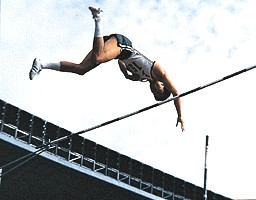1) The Interpretation of The Pole Vault Technique


撑竿跳高技术释读
2) pole vault


撑竿跳高
1.
Training load of Sun Lei,elite woman pole vaulter of China during winter period in 2004;


我国优秀女子撑竿跳高运动员孙蕾2004年冬训期训练负荷研究
2.
Main component of pole vault s additional height;


撑竿跳高腾越高度的主要构成
3.
Influence of different approach distance on technique of takeoff of pole vault;


不同助跑距离对撑竿跳高起跳技术的影响
3) pole-vault
[英]['pəul,vɔ:lt] [美]['pol,vɔlt]


撑竿跳高
1.
By reviewing papers on pole-vault studies,it is noted that in most of the studies on how to improve pole-vault performance,the focus is mainly on athletes themselves and few of the studies are related to the external environment(such as wind speed).
通过对有关撑竿跳高文章的梳理,发现在论及如何提高撑竿跳高成绩的文章中,多集中于对运动员自身的研究,而没有涉及到外部环境(风速)的研究。
2.
In recent years, the gaps among pole-vaulters have been shortened and psychological factor has become more and more important in major sports events.
近年来世界撑竿跳高水平不断提高 ,强手之间的差距越来越小 ,尤其在重大比赛中 ,运动员的心理状态直接影响到比赛的成绩。
4) pole vault lath


撑竿跳高架横竿
5) female pole vault


女子撑竿跳高
1.
This paper retrospects the developmental history of China s female pole vault and analyzes the current situation and whole level of female pole vault athletes.
对我国女子撑竿跳高发展的历史做了简要的回顾,并对我国目前女子撑竿跳高运动员的基本情况和总体水平做了总结分析,指出我国女子撑竿跳高运动存在的问题并提出相应的对策。
2.
Authors aim at describing the biommechanics of the female pole vaulting by analysing the basic technique of this event,and hope that those results will be hepful for coaches and vaulters to get a better understanding of the technique of this event, and to make the appropriate technical corrections directly after observing the errors of the athlete s techniqu
通过分析女子撑竿跳高一些较为普遍的技术动作来描述女子撑竿跳高的生物力学, 以便帮助教练员、运动员更好地理解此项运动的动作技术, 使教练员能更好地鉴别动作技术的错误, 然后快速作出适当的校正。
6) Female pole vaulting


女子撑竿跳高
1.
Female pole vaulting first came into being after the ninth modern Olympics.


女子撑竿跳高运动最早产生于第九届现代奥运会后,芬兰女子选手创造了第一个女子撑竿跳高成绩。
补充资料:撑竿跳高
| 撑竿跳高 pole vault 运动员持竿在快速助跑中,将竿插穴起跳,借助撑竿的支撑与弹力,使身体越过横竿的一种田径运动项目。撑竿跳高由原始的撑竿跳跃演变而来,作为锻炼身体的手段开始于18世纪中叶,1896年第1届奥运会列为正式比赛项目。撑竿最早用木竿,19世纪末20世纪初,采用重量轻、弹性较好的竹竿。1924年采用木制插斗。第二次世界大战后逐步使用坚固的金属竿。1962年国际业余田径联合会正式批准使用弹性强的尼龙竿。落地区铺设长5米、宽5米的海绵垫。这些设备器材的改革,促进了撑竿跳高技术的发展。
比赛时撑竿折断不算试跳失败,可以再跳一次。起跳后握竿的上手不得再向上移动,下手移动也不得超过上手。运动员试跳前可以要求前后移动跳高架,但向前移动不得超过40厘米,向落地区方向移动不得超过80厘米。撑竿跳高的完整技术是由持竿助跑、插竿起跳、悬垂摆体、后翻举腿、引体转体、过竿和落地等环节组成。握竿的高低,与助跑速度、技术水平、身高、臂长有着密切的关系。两手握距一般约70~90厘米,助跑距离在35~45米之间。助跑要求快速、平稳、自然有力。在助跑最后3步中完成降竿、举竿和插竿起跳等一系列动作。起跳点应在握竿投影点前约5~10厘米处。起跳角度约为70°~75°。起跳时右臂伸直,左臂屈成90°,左手抵住撑竿。进入悬垂阶段身体要保持短暂的反弓姿势。在身体前摆中起跳腿向摆动腿靠拢,然后以肩为轴做团身后翻举腿动作。当撑竿将要伸直时两臂沿撑竿纵轴向下做快速有力的拉引,在髋和两腿贴近撑竿上举中向左转成单臂倒立姿势。当大腿腾越过竿时,小腿下压,紧接着做收腹、含胸、低头等动作,使躯干和头依次以弧形过竿,然后团身落在海绵垫上。 |
说明:补充资料仅用于学习参考,请勿用于其它任何用途。
参考词条
